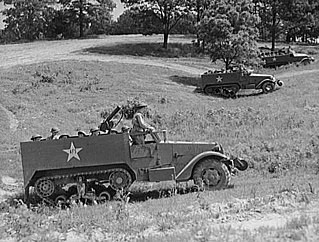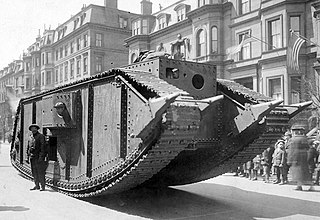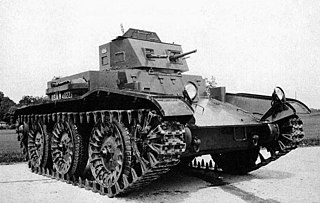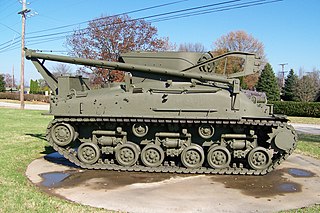
A military armoredcar is a wheeled armored fighting vehicle, historically employed for reconnaissance, internal security, armed escort, and other subordinate battlefield tasks. With the gradual decline of mounted cavalry, armored cars were developed for carrying out duties formerly assigned to light cavalry. Following the invention of the tank, the armored car remained popular due to its faster speed, comparatively simple maintenance and low production cost. It also found favor with several colonial armies as a cheaper weapon for use in underdeveloped regions. During World War II, most armored cars were engineered for reconnaissance and passive observation, while others were devoted to communications tasks. Some equipped with heavier armament could even substitute for tracked combat vehicles in favorable conditions—such as pursuit or flanking maneuvers during the North African campaign.

The Leichter Panzerspähwagen was a series of light four-wheel drive armoured cars produced by Nazi Germany from 1935 to 1944.

The M3 half-track was an American armored personnel carrier half-track widely used by the Allies during World War II and in the Cold War. Derived from the M2 half-track car, the M3 was extensively produced, with about 15,000 standard M3s and more than 38,000 variant units manufactured.

The M8 light armored car is a 6×6 armored car produced by the Ford Motor Company during World War II. It was used from 1943 by United States and British forces in Europe and the Pacific until the end of the war. The vehicle was widely exported and as of 2024 still remained in service with some countries.

The M3 Scout Car was an American-produced armored car. The original M3 Scout Car was produced in limited numbers, while the improved M3A1 Scout Car saw wide service during World War II and after.

The Steam tank (tracked) was an early U.S. tank design of 1918 imitating the design of the British Mark IV tank but powered by steam.

The FV721 Fox Combat Vehicle Reconnaissance (Wheeled) (CVR(W)) was a 4 × 4 armoured car manufactured by ROF Leeds, deployed by the British Army as a replacement for the Ferret scout car and the Saladin armoured car. The Fox was introduced into service with B Squadron, 1st Royal Tank Regiment (Aliwal Barracks, Tidworth) in 1975 and withdrawn from service 1993–94.

The Marmon–Herrington armoured car was a series of armoured vehicles that were produced in South Africa and adopted by the British Army during World War II. They were also issued to RAF armoured car companies, which seem never to have used them in action, making greater use of Rolls-Royce Armoured Cars and other types.

The Panhard EBR is an armoured car designed by Panhard for the French Army and later used across the globe, notably by the French Army during the Algerian War and by the Portuguese Army during the Portuguese Colonial War.

The OA vz. 27 was a Czechoslovak-designed armored car used by Nazi Germany, Slovakia, and Romania during World War II. Fifteen were built, of which the Germans seized nine when they occupied Bohemia-Moravia in March 1939 and the Slovaks captured three when they declared independence from Czechoslovakia at the same time. Romania acquired three when Czech troops sought refuge in Romania after the Hungarian invasion of Carpatho-Ukraine that same month. All were used for training or internal security duties during the war.

The Dozor-B is a four-wheeled Ukrainian armored car.
Continental Motors Company was an American manufacturer of internal combustion engines. The company produced engines as a supplier to many independent manufacturers of automobiles, tractors, trucks, and stationary equipment from the 1900s through the 1960s. Continental Motors also produced automobiles in 1932–1933 under the name Continental Automobile Company. The Continental Aircraft Engine Company was formed in 1929 to develop and produce its aircraft engines, and would become the core business of Continental Motors, Inc.

Sd.Kfz. 247 was an armored car used by the German armed forces during World War II.

The Büssing A5P was an armoured car produced in Germany during World War I.

T7 combat car was a prototype United States light tank design of the interwar period. It could run on rubber-tired wheels on roads or mount tracks for cross-country use. Although adequate in some areas, it lacked armament compared to contemporary vehicles and the project was cancelled after only one was built.

The T17 armored car, sometimes referred to as the M5 medium armored car and by the British as the Deerhound, was an American six-wheeled armored car produced during the Second World War.

The Chiyoda armoured car was the first domestic Japanese armoured car which was officially introduced by the Imperial Japanese Army (IJA) and produced in the 1930s.

The M15 half-track, officially designated M15 Combination Gun Motor Carriage, was a self-propelled anti-aircraft gun on a half-track chassis used by the United States Army during World War II. It was equipped with one 37 millimeter (1.5 in) M1 autocannon and two water-cooled .50 caliber (12.7 mm) M2 Browning heavy machine guns. Based on the M3 half-track chassis, it was produced by the Autocar Company between July 1942 and February 1944, and served alongside the M16 Multiple Gun Motor Carriage.

The M32 tank recovery vehicle was an armored recovery vehicle (ARV) used during World War II and the Korean War by the United States, and was based on the chassis of the M4 Sherman medium tank. During World War II, the British also used several hundred M32s, which were obtained through Lend-Lease in 1944. The first four prototypes were produced in January 1943, labeled T5, T5E1, T5E2, T5E3, and T5E4. After a series of tests at the Aberdeen Proving Grounds, the prototypes were approved as M32, M32E1, M32E2, M32E3, and M32E4. However, the M32E4 never entered production. There were also variants that had horizontal volute spring suspension (HVSS), which were demarcated by the suffix "A1" after the model number.
The Panhard AM 40 P, also known as Model 201, was a prototype French armoured car.


















